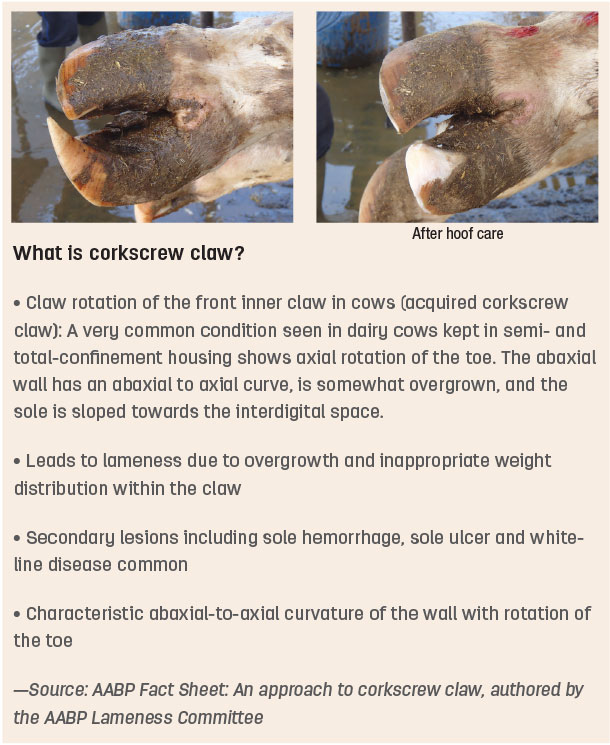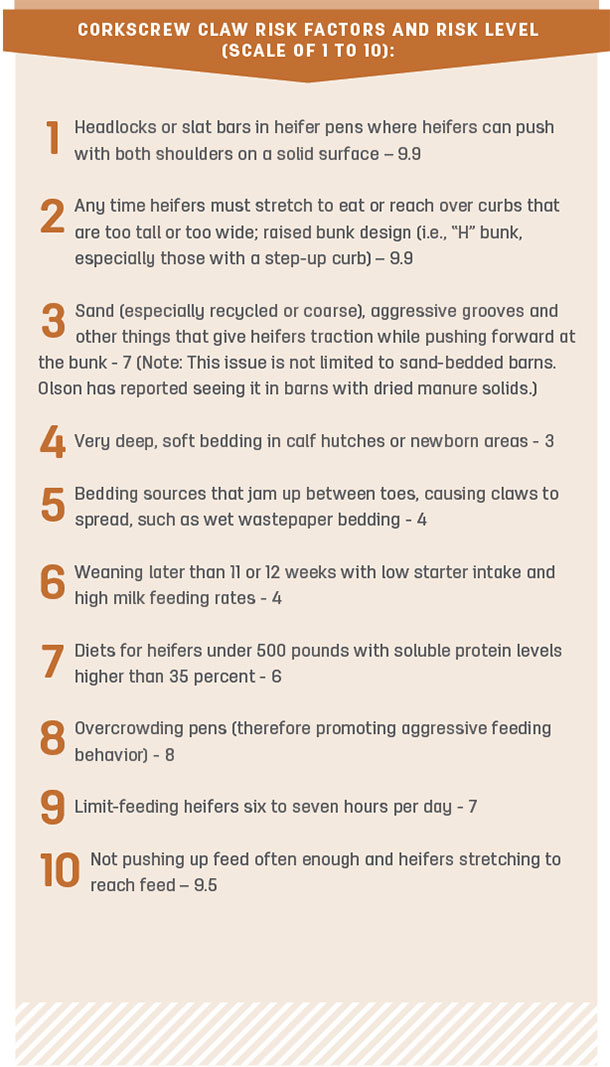For several years, Shiloh Dairy in Brillion, Wisconsin, was troubled by an epidemic of twisted and turned-up toes on cows’ and heifers’ front feet, but with the help of a committed consultant, they have successfully taken control of corkscrew claws.
The mystery of the corkscrew claws
The 2,100-cow dairy first noticed a problem in front feet about seven years ago, as cows tip-toed into the milking parlor. “The cows had twisted front feet, narrow stances and thin soles,” Travis Speirs, herd manager, recalls. “The young cows walked gingerly. We were using lots of blocks on front feet for thin soles.”
The curved hoof wall and rotated toes fit the description of a corkscrew claw, but they didn’t follow the typical pattern. According to the American Association of Bovine Practitioners (AABP), the condition most often occurs in the hind legs of cattle older than 3.5 years.
At Shiloh Dairy, however, twisted toes appeared on the front feet of first-lactation cows and even heifers under 6 months old. Though there is a recognized genetic correlation to corkscrew claw, the prevalence of it here was far beyond heritability.
As a result of hoof overgrowth and uneven weight distribution, these animals were also suffering from painful secondary lesions that forced culling.
“At first, it was aesthetic, but then it became a functional problem,” Speirs adds. “We had a lot of heifers that weren’t making it to calving.”
The Speirs were frustrated, to say the least, as consultants offered their suggestions to no avail. Nutritionists recommended keeping the bunk full and understocking pens, citing that aggressive feeding behavior and pushing against headlocks was contributing to corkscrew claws, but the well-managed dairy already practiced a rigorous feed push-up schedule and avidly avoided overcrowding.
They changed out the sand bedding in the freestalls and separated stones and large particles, which seemed to help but was not a silver-bullet solution.
Cracking the corkscrew code
With very little information or research to reference on this specific condition, the head-scratching continued. By the time Roger Olson, Zinpro dairy account manager, came to Shiloh Dairy, corkscrew claws were more common than not.
“It was pretty significant,” Olson reflects, “with a high 80 percent of the herd with corkscrews.”
Having seen a few other herds challenged in the same way, Olson used his experience and called on his worldwide network of colleagues to assess the situation and offer possible solutions. With the help of a trail camera mounted in the heifer transition barn, he observed feeding times and pushups, ruling that out as the number one cause.
What he did discover, however, was: Heifers were putting an incredible amount of force on their shoulders as they reached through slat bars to eat. Even with the feed pushed completely up, he estimated these animals were pushing forward with 90 to 110 pounds of pressure.
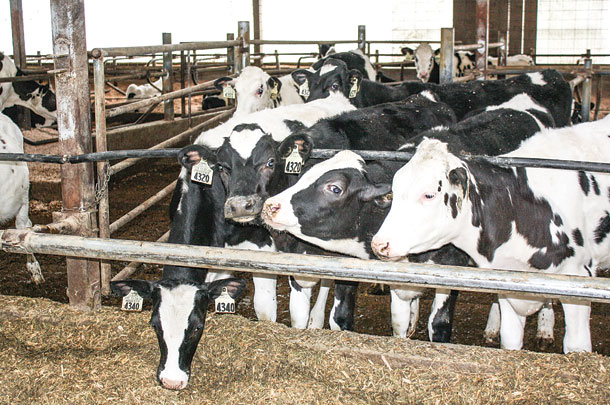
Doing this for several hours each day, he explains, was causing the front feet to push out and the pedal bone inside of the claw capsule to rotate. This was permanently damaging the ligaments in the hooves of the young, growing heifers, therefore limiting flexibility as calcification took place. By the time these heifers reached freshening, their feet were irreparable.
The corkscrew appearance was really the result of the rotated bone within the foot, making it difficult for a hoof trimmer to correct. “Trimming couldn’t fix it,” Speirs says. “The best we could do was make them ‘functionally ugly.’”
In an effort to relieve the pressure points on heifers’ shoulders, the dairy replaced slat bars with an open-rail feeding system and cut the curb height down on several pens.
Through months of observation, these changes appeared to alleviate some of the corkscrews – but as they tracked it across seasons, another trend surfaced. The switch from sawdust bedding in the heifer transition barn in the cooler months to sand in the summer months triggered a significant increase in early signs of claw rotation.
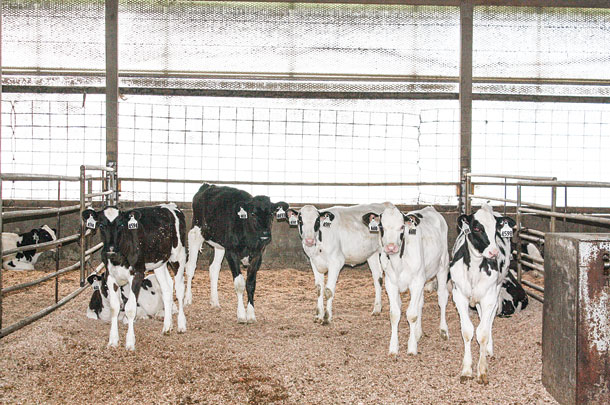
“When we switched bedding for the season, it was night-and-day difference in a couple of weeks,” Speirs says. With the hunch sand was to blame, he and Olson conducted head-to-head trials over the next few weeks using a scoring system created by Olson.
It used a scale of 1 through 3 to denote the degree of axial wall rotation along with the width of the split between the front toes. According to his evaluation, of the heifers kept on sawdust, only 13 percent showed a larger-than-normal split (greater than 2 centimeters) between front toes while an astonishing 83 percent of those on sand displayed this precursor to corkscrew claws.
These numbers said it all for Speirs; it was clear putting young heifers on sand was exacerbating the claw rotation problem. He picked up the phone and replaced the sand with sawdust in the heifer transition barn that very day.
While he concedes flies are now a bigger issue than with non-organic bedding, he confirms his decision, noting, “I’d rather deal with flies than bad feet.”
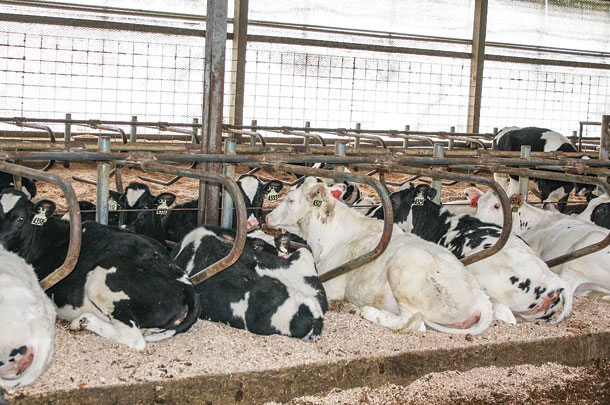
The dairy is currently testing out the appropriate age to introduce heifers to sand bedding without a detriment to hooves. Olson believes 6 months old may be the “magic number.”
‘We were killing them with kindness’
Discovering the connections among corkscrew claws, sand bedding and shoulder pressure among heifers was a great stride in Shiloh Dairy’s mission to get the condition under control. Yet Olson helped to uncover one more unassuming factor that predisposed otherwise healthy heifers to front feet problems: an intense calf-raising program.
Shiloh’s stellar, by-the-book calf management protocol seemed like the last place that could be setting the stage for corkscrews. Calves were meticulously managed and fed milk for 11 weeks before weaning; following the principles of “clean” and “dry,” hutches were bedded with several inches of sand. However, these practices were actually promoting the claw disorder.
“We were killing them with kindness,” Cathy Speirs, the dairy’s genetics, maternity and calf manager admits.
It turned out the high level of milk consumption deterred starter intake, which left calves deficient in key minerals essential for foot health, like zinc and copper. And the deep bed of sand caused claw splitting in baby calves as sand compacted between their toes. Fortunately, correcting these concerns was a matter of a few simple tweaks.
“We changed weaning from 11 weeks to 10 weeks and introduced hay earlier. We were feeding lots of solids, but the calves needed to be eating more starter to meet mineral requirements,” Speirs says. “We still use sand to bed hutches in the summer [and straw in the winter], but we don’t use as much now in order to prevent packing between toes.”
Making strides
Olson believes he will continue to see other dairies challenged by corkscrew claws on the front feet of young heifers. In fact, he notices it most often among progressive, well-managed herds with intense rearing programs, particularly those where animals are on concrete starting at a young age.
He has summarized probable causes of twisted front toes (see right). While Olson emphasizes these factors are based solely on his personal experience, and not backed by scientific studies, this may be one of the most comprehensive lists available for identifying risk factors among heifers.
Looking ahead, Speirs says it will take getting through a couple more generations of cows before the milking barns are mostly free from corkscrew claws.
In the meantime, regularly trimming heifers at 150 days in-calf and again 60 days postfresh helps to keep the claw capsule balanced and maintain sole depth, particularly at the point where the pedal bone rotates.
After many years of battling it, Shiloh Dairy is nearly rid of the corkscrew claw problem. In fact, during one of Olson’s most recent assessments, he estimated only about 3 percent of the heifer herd with signs of claw rotation. He and Speirs confidently agree, “They look so good, I think we can say we’ve got it.” ![]()
PHOTO 1: Together, Shiloh Dairy Herd Manager Travis Speirs and Zinpro Dairy Account Manager Roger Olson worked together to dramatically reduce corkscrew claws among the dairy’s heifers. Effective actions included removing slat bars, delaying introduction to sand bedding until after 6 months old and adjusting the calf-feeding protocol.
PHOTO 2: Replacing slat bars in the heifer transition barn with a permanently mounted pipe and covered cable has prevented corkscrew claw in post-weaned calves by removing pressure points on the animals’ shoulders. Keeping feed pushed up to the bunk has also shown to help. MIDDLE
PHOTO 3 & 4: Bedding heifer group pens and freestalls with sawdust instead of sand has dramatically reduced the incidence of corkscrew claws among heifers.

-
Peggy Coffeen
- Editor
- Progressive Dairyman
- Email Peggy Coffeen
